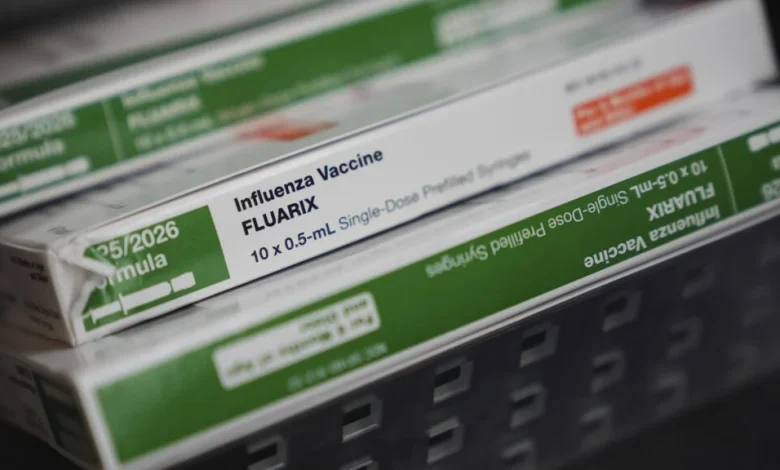Is a bad flu season on the way? Experts see reason to be anxious

Last winter, for the first time since Covid-19 entered our world, influenza reclaimed its spot as the worst actor among the cast of viruses that sicken people during the cold and flu season. The 2024-2025 season was a bad flu year.
There are early indications that flu may be going for a twofer.
One family of flu viruses has recently undergone important genetic changes that both could make people more susceptible to getting sick and could mean this season’s flu vaccine may convey reduced protection. The family, known as H3N2, is generally acknowledged as the nastier of the two subtypes of influenza A viruses. The new variant, named subclade K, started to spread in June and July, months after vaccine manufacturers had been told what strains to target in the 2025-2026 Northern Hemisphere flu shots.
The prospect of an H3N2 vaccine mismatch always worries influenza experts. And they are watching closely to see how this situation plays out as flu activity in North America starts to pick up. Some are quite alarmed. Others think there may be mitigating factors that could help us weather this season. But all would argue that getting a flu shot this year is still worth the momentary sting of the needle.
“If there’s ever a year to get a flu vaccine, this is the year,” said Scott Hensley, a microbiologist and influenza vaccine scientist at the University of Pennsylvania.
RFK Jr.’s warnings on thimerosal in vaccines threaten to instill doubt overseas, experts fear
The mutations H3N2 has accrued suggest subclade K viruses may help them evade the antibodies people’s immune systems have developed for this strain of flu, whether those antibodies were generated by infection or by getting this year’s flu shot. The location of the mutations could affect the ability of antibodies to bind to this new virus, which could in turn lead to a heightened burden of flu this year, Hensley said.
Kanta Subbarao, an influenza expert in the department of microbiology and immunology at Laval University in Quebec City, also stressed that people shouldn’t interpret the news about subclade K as a reason to skip getting a flu shot this year. For starters, she said, the shot also protects against H1N1, the other influenza A virus, and against flu B, as well as other H3N2 viruses that are not from subclade K.
Subbarao and Hensley noted that even if the vaccine doesn’t prevent subclade K infections, studies in previous seasons with vaccine mismatches have shown that people who receive a flu shot were often less likely to become sick enough to require hospital care.
This was the case in 2014-2015, when despite a bad H3N2 vaccine mismatch and little evidence the vaccine prevented infection, the shots provided better-than-expected protection against illness requiring hospitalization.
Arnold Monto, a veteran influenza vaccine researcher and a professor emeritus at the University of Michigan’s School of Public Health, was the senior author on a study that reported on the 2014-2015 season. He’s among the flu experts who are hedging their bets on how bad this flu season might be. Given how many people were infected with influenza last winter, Monto believes there could well be some residual immunity in a sizable portion of the population, even if the H3N2 viruses have mutated.
H3N2 viruses accounted for about half of the flu activity in the United States last winter, which was the most severe season in years.
Florian Krammer, a flu virologist at Mount Sinai’s Icahn School of Medicine in New York, agreed. “Here we had a very strong H3N2 season last year. And of course the virus changed, but there might be some protection from that H3N2 season,” he said.
Subclade K viruses emerged late in the Southern Hemisphere’s winter this year, and are the dominant viruses now in the United Kingdom and Japan, which are experiencing early starts to their flu seasons.
In response to the new flu threat, scientists from the U.K.’s Health Security Agency did an early study trying to determine how effective this year’s flu shot is at protecting against subclade K. They reported last week in a preprint — a paper that hasn’t yet gone through peer review — that they saw reassuring levels of protection in people who were vaccinated. In children and teens, the vaccine was 70% to 75% effective at preventing the need for hospital care; in adults, the protection against requiring hospital care was between 30% to 40%. They warned, though, that the results were based on testing conducted soon after the people who were studied had been vaccinated, and that protection might wane as time goes on.
Danuta Skowronski, who with colleagues published an analysis of the changes in the subclade K viruses late last month, is among those flu experts who are concerned about what this variant’s emergence portends for this winter.
“We think it definitely is a variant that requires close monitoring for the coming season,” said Skowronski, who is a physician-epidemiologist at the BC Centre for Disease Control in Vancouver. “And already, of course, it’s showing that where it is appearing, it’s pretty much taking over.”
Sign up for Daily Recap
All the health and medical news you need today, in one email
In its first flu report for the 2025-2026 season, published last Friday after the government shutdown ended, the Centers for Disease Control and Prevention reported that while flu activity is still at low levels in the United States, most of the viruses studied so far have been influenza A viruses and about 63% of those are H3N2s. Of those H3N2 viruses that have been analyzed to date, half are subclade K viruses.
Skowronski is dubious that the U.K.’s early estimates of this season’s flu vaccine’s effectiveness against subclade K will hold up as the winter progresses and the time from most people’s vaccination lengthens. “I would say the jury is still out and that we do need [vaccine effectiveness] estimates as soon as they can be validly provided and that really requires some stability in the vaccine coverage.”
Hensley, too, expects the new viruses to show greater capacity to escape the immunity the flu shot induces — and he anticipates having some evidence of that soon. His lab is currently studying blood drawn from people who were vaccinated with this season’s flu shot to see how well the antibodies in the samples recognize subclade K viruses. They should have results from that work in a couple of weeks, he said.
Australia, in the Southern Hemisphere, already has some recent experience with these viruses. There, a flu season that started out driven mainly by H1N1 activity was pushed well past its typical end in late August and early September when subclade K viruses arrived and started to circulate.
Ian Barr, deputy director of the World Health Organization’s Collaborating Centre for Reference and Research on Influenza in Melbourne, told STAT in an email late last week that the country is still recording laboratory-confirmed cases, with 441,000 so far in 2025. That compares to 363,000 in 2024 and 289,000 in 2023.
Barr said the Melbourne collaborating center is looking to see if there are any signs that the subclade K viruses trigger more severe illness, but to date they’ve seen “nothing alarming.”
So will this flu season be another bad one in North America? Talk to influenza experts long enough, and they are bound to remark that trying for forecast flu is a fool’s errand. “It’s just not smart to try to predict flu,” Subbarao said. “I know better. So I’m not going to predict what the season’s going to do.”





